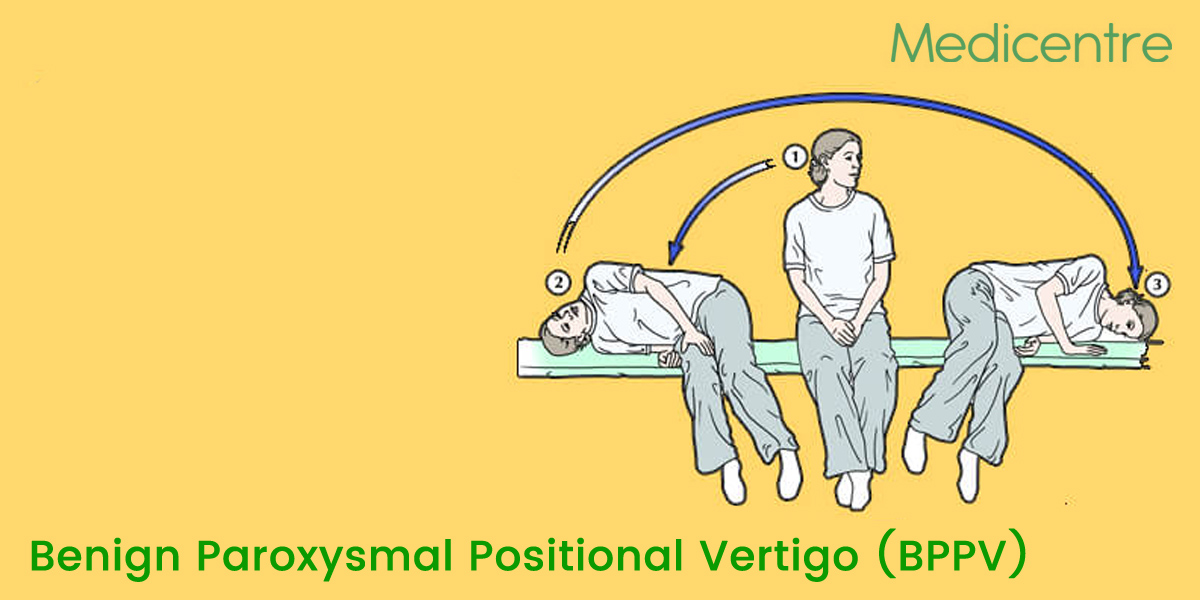Benign Paroxysmal Positional Vertigo (BPPV)
Vertigo is prevalent in a lot of forms and one of these which is also the most common cause is Benign paroxysmal positional vertigo or BPPV. It stimulates a spinning sensation in the head and makes the person feel like everything along with them is spinning. It is usually observed with brief instances of mild to extreme forms of dizziness. Certain changes in the positions of the head like tipping it up or down and lying down or sitting up on the bed can trigger it. One could also feel dizzy and unable to stand or walk. Even though BPPV can be very troublesome, it is rarely serious or life-threatening. Effective treatment can be sought for this easily.

What are the Symptoms of Benign Paroxysmal Positional Vertigo (BPPV)
Some of the symptoms for Benign paroxysmal positional vertigo include dizziness, unsteadiness, lightheadedness, imbalance, spinning or moving sensation, rhythmic abnormal eye movement, nausea, blurry vision, and vomiting. These symptoms can keep reappearing and disappearing, commonly taking place for less than a minute. The activities that bring about these symptoms can be different in various people.
- Paralysis of your face on one side
- Difficulty in smiling or closing eyes
- Increased audio-related sensitivity on the paralyzed side
- Pain in the jaw at the affected area
- Headache and changes in the saliva or tears produced by you
- Issues faced in the taste buds
What are the Causes of Benign Paroxysmal Positional Vertigo (BPPV)
Most of the times the exact cause of Benign paroxysmal positional vertigo is not found. Usually, the cause is due to a minor or serious blow to the head. Damage to the inner ear or during an ear surgery, although rare, can also result in BPPV. Strained positioning of the back and migraines are also connected to it.
The Role of the Ear
It is already known that ears help in the balance of the body. The inside part of the ear is known as the vestibular labyrinth and it is a tiny organ which has three structures that are loop-shaped. These semicircular canals contain fluid along with fine, sensors that are hair-like and monitor the rotation of the head. Other structures of the ear also contain crystals which make the head and mind more sensitive to the gravity that is experienced. These crystals could get dislodged and mobe into the loop-shaped structures. Due to this, the semicircular canal can become very sensitive to changes in the position of the head making the person feel dizzy and feel like the world is spinning when in reality it is not.
What are the Risk Factors of Benign Paroxysmal Positional Vertigo (BPPV)
Benign paroxysmal positional vertigo mostly takes place in people aged 60 or older. However, people at any other age can also get this problem. Apart from aging, not many definite factors are available which could potentially increase the risk of someone getting PBBV. An injury to the head or disorder of the balance of any other organs for balance like ear could also increase the chances of one getting Benign paroxysmal positional vertigo.
Treatment for Benign Paroxysmal Positional Vertigo (BPPV)
One should visit the doctor if any kind of vertigo or dizziness recurs with signs like different and severe headache, 101 Fahrenheit fever or higher, loss of vision and hearing, trouble in speaking, weakness in legs or arms, fainting, difficulty in walking or falling, a tingling sensation or numbness, pain in the chest, etc.
Treatment can be done using movements known as the canalith repositioning procedure. It moves particles from semicircular canals filled with fluid into a tiny open area called vestibule having one of the otolith organs where the particles can be resorbed more easily. Each position is fixed for 30 seconds after any abnormal eye movements or symptoms stop. The procedure is usually effective after around two treatments. Surgical methods are another alternative for cure which blocks the portion of the inner ear causing dizziness.
Complications
Even though it can be argued that Benign paroxysmal positional vertigo is very troubling, inconvenient and also makes the person feel uncomfortable, it is very rare to have any complications regarding the disease. It does not become too serious and can be treated by visiting the doctor. In severe cases, it could cause a person to go through excessive vomiting which in turn causes dehydration and the dizziness and lightheadedness also increase the probability of falling.
Preparing for the appointment is vital and it must be ensured that the patient is clear about their symptoms and queries before going in front of the doctor. The doctor will ask a number of questions regarding the health of the individual in order to deduce whether it is actually Benign paroxysmal positional vertigo or not. Writing down the signs and symptoms could be a good idea and help the patient explain them to the doctor clearly also.